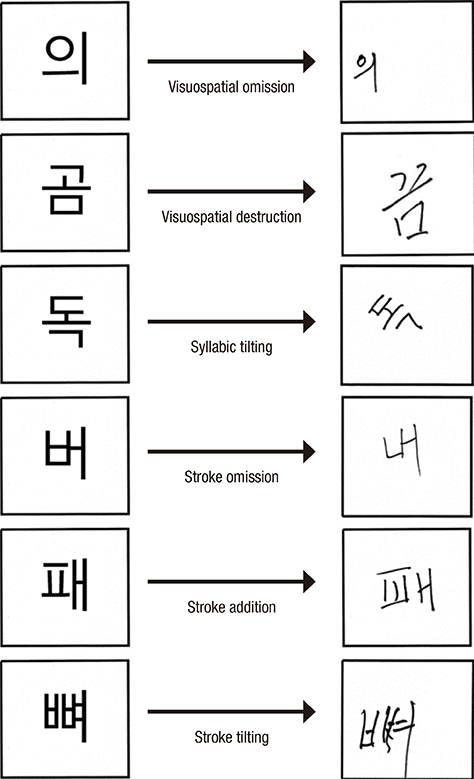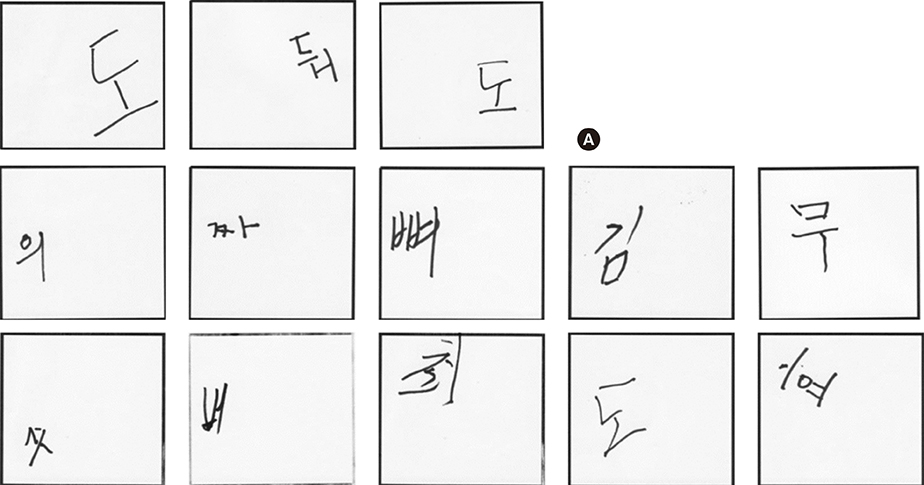J Korean Med Sci.
2015 Mar;30(3):323-327. 10.3346/jkms.2015.30.3.323.
Language-specific Dysgraphia in Korean Patients with Right Brain Stroke: Influence of Unilateral Spatial Neglect
- Affiliations
-
- 1Department of Rehabilitation Medicine, Incheon St. Mary's Hospital, College of Medicine, The Catholic University of Korea, Incheon, Korea. minukkim@nate.com
- KMID: 2133312
- DOI: http://doi.org/10.3346/jkms.2015.30.3.323
Abstract
- The purpose of the present study was to investigate the relationship between Korean language-specific dysgraphia and unilateral spatial neglect in 31 right brain stroke patients. All patients were tested for writing errors in spontaneous writing, dictation, and copying tests. The dysgraphia was classified into visuospatial omission, visuospatial destruction, syllabic tilting, stroke omission, stroke addition, and stroke tilting. Twenty-three (77.4%) of the 31 patients made dysgraphia and 18 (58.1%) demonstrated unilateral spatial neglect. The visuospatial omission was the most common dysgraphia followed by stroke addition and omission errors. The highest number of errors was made in the copying and the least was in the spontaneous writing test. Patients with unilateral spatial neglect made a significantly higher number of dysgraphia in the copying test than those without. We identified specific dysgraphia features such as a right side space omission and a vertical stroke addition in Korean right brain stroke patients. In conclusion, unilateral spatial neglect influences copy writing system of Korean language in patients with right brain stroke.
Keyword
MeSH Terms
Figure
Reference
-
1. Ardila A, Rosselli M. Spatial agraphia. Brain Cogn. 1993; 22:137–147.2. Seki K, Ishiai S, Koyama Y, Sato S, Hirabayashi H, Inaki K, Nakayama T. Effects of unilateral spatial neglect on spatial agraphia of kana and kanji letters. Brain Lang. 1998; 63:256–275.3. Caramazza A, Hillis AE. Spatial representation of words in the brain implied by studies of a unilateral neglect patient. Nature. 1990; 346:267–269.4. Rode G, Pisella L, Marsal L, Mercier S, Rossetti Y, Boisson D. Prism adaptation improves spatial dysgraphia following right brain damage. Neuropsychologia. 2006; 44:2487–2493.5. Yoon JH, Suh MK, Kim H. Language-specific dysgraphia in Korean stroke patients. Cogn Behav Neurol. 2010; 23:247–255.6. Cubelli R. A selective deficit for writing vowels in acquired dysgraphia. Nature. 1991; 353:258–260.7. Kim H, Na DL. Normative data on the Korean version of the Western Aphasia Battery. J Clin Exp Neuropsychol. 2004; 26:1011–1020.8. Schenkenberg T, Bradford DC, Ajax ET. Line bisection and unilateral visual neglect in patients with neurologic impairment. Neurology. 1980; 30:509–517.9. Albert ML. A simple test of visual neglect. Neurology. 1973; 23:658–664.10. Halligan PW, Marshall JC, Wade DT. Visuospatial neglect: underlying factors and test sensitivity. Lancet. 1989; 2:908–911.
- Full Text Links
- Actions
-
Cited
- CITED
-
- Close
- Share
- Similar articles
-
- Subtypes of Spatial Neglect and Assessment
- Neuroanatomy of Unilateral Neglect Syndrome
- Effect of Computer-based Cognitive Rehabilitation on Unilateral Spatial Neglect in Stroke Patients
- The Effect of Virtual Reality Training on Unilateral Spatial Neglect in Stroke Patients
- Relationship between Comorbid Cognitive Impairment and Functional Outcomes in Stroke Patients with Spatial Neglect




